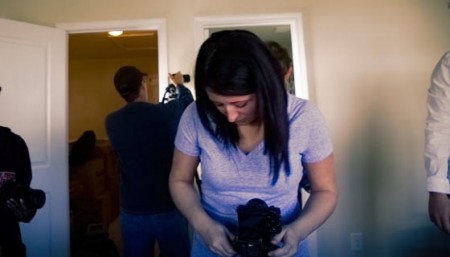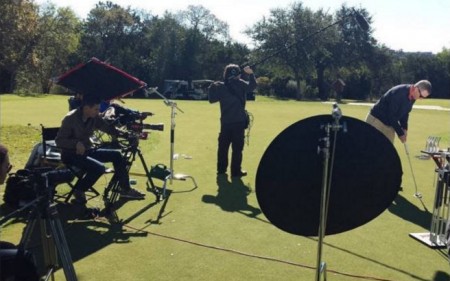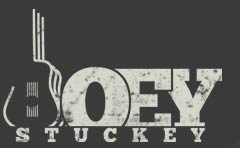Please fill out the following information, and RRFC Admissions will contact you to discuss our program offerings:
Issue #98 - Page 2
by L. Swift and Jeff McQ

On the set of Facade
 From being on the links to shoot an Edel Golf training video, to the set of indie film Terror Birds, Film Connection apprentice Travis Pointer (San Antonio, Texas) is happy he’s getting to be a part of it all with his mentor Christine Chen of Moth to Flame Films.
From being on the links to shoot an Edel Golf training video, to the set of indie film Terror Birds, Film Connection apprentice Travis Pointer (San Antonio, Texas) is happy he’s getting to be a part of it all with his mentor Christine Chen of Moth to Flame Films.

 It’s fair to say the sighted community and software manufacturers are largely blind to the needs of visually impaired engineers, producers, and artists. The digital audio workstations of today are 2-dimentional, making it impossible for a blind engineer to man the controls solo. Joey’s workaround system is composed of a screen reader that interfaces with SONAR. He says, “I can see…for lack of a better word, I can see things like, ‘Okay, my track is armed. Or, my track not armed. My track is muted. My track is not muted.’ I can also select clips to edit…One of the problems for example is, if I…like, let’s say you’re using something like Melodyne, and you want to go in to adjust the rhythm of an instrument, or you want to go in and adjust the pitch of a vocal, that is a lot less accessible for me because the screen reader does not have the ability to look at the WAV form and sort of zoom in where you can make those really fine-tuned adjustments.” Thus far, when Joey wants to isolate and work on editing WAV, he does the brain and ear work but needs a sighted person to actually move the controls.
One of the technologies Joey is helping researchers beta test, called the Haptic Wave, is a control surface aimed at addressing this problem. Researchers from Goldsmiths flew over from London, England to Macon, Georgia specifically to work one-on-one with Joey and run through a number of experiments. Joey describes the Haptic Wave interface in this way: “Essentially what you have is the X and a Y axis. So it’s a fairly simple device to build…it’s got two faders on it. It’s got one fader that goes from left to right, and then another fader, a smaller one, on top of that fader that goes up and down…As you scrub left to right, it takes you through the wave form, and moves you through the audio. And then, the other fader that moves up and down, bounces around to show you what the amplitude is. So as you move from left to right, the other fader moves up and down and gives you decibel levels… That’s really handy when you’re looking for transients. Like, ‘Oh, here’s the kick drum. I can see that this is where the kick…the heavy attack’s at_, so I want to move this a beat earlier,’ or whatever. It’s in the very early development stages.”
Joey is also helping beta test a technology developed at Queen Mary University of London. They’ve developed a plugin called the Accessible Peak Meter (available now for free). The technology enables blind engineers to define parameters telling them when they’ve hit certain decibel level on a track. “If you’re looking for peaks, you know, it will actually beep and tell you when you’ve hit that peak. And of course you can have as many instances as you want, on as many tracks as you want. If you just want it over your master bus, you know, that’s fine. Or if you want it on each track, that’s fine… It’s a brilliant piece of technology. And now, they’re talking about trying to find a way to make spectrum analyzers more accessible by using different tones.”
So how does Joey feel about the contribution he’s making to the world? He’s downright jazzed about it.
“I came back from that conference re-inspired to do more. I’ve done a lot, but I’ve become more inspired to do more. Because honestly, you know, most of the blind musicians that were there are not at the same place that I am in their journey. They haven’t had the opportunities I’ve had. They haven’t had the ability to do the things that I’ve done professionally and a lot of them really deserve it. There’s some incredible talent. And so I thought, ‘Man, I need to come back and help make sure that these people get a chance to be heard.’”
Keep on being part of the solution Joey! Change is on the way and we’re proud Recording Connection mentor Joey Stuckey is at the forefront of making it happen!
It’s fair to say the sighted community and software manufacturers are largely blind to the needs of visually impaired engineers, producers, and artists. The digital audio workstations of today are 2-dimentional, making it impossible for a blind engineer to man the controls solo. Joey’s workaround system is composed of a screen reader that interfaces with SONAR. He says, “I can see…for lack of a better word, I can see things like, ‘Okay, my track is armed. Or, my track not armed. My track is muted. My track is not muted.’ I can also select clips to edit…One of the problems for example is, if I…like, let’s say you’re using something like Melodyne, and you want to go in to adjust the rhythm of an instrument, or you want to go in and adjust the pitch of a vocal, that is a lot less accessible for me because the screen reader does not have the ability to look at the WAV form and sort of zoom in where you can make those really fine-tuned adjustments.” Thus far, when Joey wants to isolate and work on editing WAV, he does the brain and ear work but needs a sighted person to actually move the controls.
One of the technologies Joey is helping researchers beta test, called the Haptic Wave, is a control surface aimed at addressing this problem. Researchers from Goldsmiths flew over from London, England to Macon, Georgia specifically to work one-on-one with Joey and run through a number of experiments. Joey describes the Haptic Wave interface in this way: “Essentially what you have is the X and a Y axis. So it’s a fairly simple device to build…it’s got two faders on it. It’s got one fader that goes from left to right, and then another fader, a smaller one, on top of that fader that goes up and down…As you scrub left to right, it takes you through the wave form, and moves you through the audio. And then, the other fader that moves up and down, bounces around to show you what the amplitude is. So as you move from left to right, the other fader moves up and down and gives you decibel levels… That’s really handy when you’re looking for transients. Like, ‘Oh, here’s the kick drum. I can see that this is where the kick…the heavy attack’s at_, so I want to move this a beat earlier,’ or whatever. It’s in the very early development stages.”
Joey is also helping beta test a technology developed at Queen Mary University of London. They’ve developed a plugin called the Accessible Peak Meter (available now for free). The technology enables blind engineers to define parameters telling them when they’ve hit certain decibel level on a track. “If you’re looking for peaks, you know, it will actually beep and tell you when you’ve hit that peak. And of course you can have as many instances as you want, on as many tracks as you want. If you just want it over your master bus, you know, that’s fine. Or if you want it on each track, that’s fine… It’s a brilliant piece of technology. And now, they’re talking about trying to find a way to make spectrum analyzers more accessible by using different tones.”
So how does Joey feel about the contribution he’s making to the world? He’s downright jazzed about it.
“I came back from that conference re-inspired to do more. I’ve done a lot, but I’ve become more inspired to do more. Because honestly, you know, most of the blind musicians that were there are not at the same place that I am in their journey. They haven’t had the opportunities I’ve had. They haven’t had the ability to do the things that I’ve done professionally and a lot of them really deserve it. There’s some incredible talent. And so I thought, ‘Man, I need to come back and help make sure that these people get a chance to be heard.’”
Keep on being part of the solution Joey! Change is on the way and we’re proud Recording Connection mentor Joey Stuckey is at the forefront of making it happen!



RRFC is education upgraded for the 21st century.
Get the latest career advice, insider production tips, and more!
Please fill out the following information, and RRFC Admissions will contact you to discuss our program offerings:
Stay in the Loop: Subscribe for RRFC news & updates!
© 2025 Recording Radio Film Connection & CASA Schools. All Rights Reserved.


